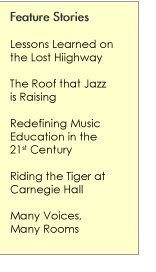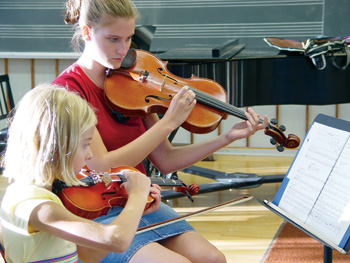

|
| Home :: Features :: Redefining Music Education in the 21st Century Redefining Music Education in the 21st Century By Andrea Kalyn
“This is a bold endeavor by Oberlin,” says Dean of the Conservatory David H. Stull. He is describing the Conservatory’s work over the past two years to redesign its music education program in a way that addresses the emerging challenges in K-12 education in the United States. The result is a new Master of Music Teaching program that is projected to enroll its first class in 2008. “Oberlin has always met the challenges of the profession with optimism and strategic vision,” says Stull. “The new music education program is designed to look at how we best train our students to enter the field with ideas, vision, and the tools to make a positive impact on their communities.” Indeed, the history of the Conservatory’s music education program is marked by similarly bold endeavors. Since 1902, when the Conservatory offered its first courses in music education, the program has pioneered in the field. In 1921, Oberlin initiated the first four-year college degree program in music education in the United States. Professor of Music Education Clifford Cook introduced the Suzuki method of musical instruction to the United States in 1958. Oberlin was one of the first music schools authorized by the Ohio Department of Education to grant teacher certification. Moreover, Huang Tzu, a 1926 Oberlin graduate, cofounded the Shanghai Conservatory and established the curricular platform for all subsequent professional musical study in China. Empowered by this rich history, the music education faculty and the Dean reviewed Oberlin’s music education curriculum in relation to the changing landscape of K-12 education. In the era of No Child Left Behind and shrinking budgets, public school districts are all too often forced to siphon money away from the arts in order to raise test scores in subjects deemed “core.” Research by the U.S. Department of Education suggests that, concurrent with these fiscal changes, the demand among parents for alternatives and enriched educational experiences has grown.1 Charter schools, private schools, and community music schools can be more flexible in terms of curriculum and hiring, albeit often at the expense of the licensure requirements of public school systems. Recent statistics indicate that fewer than half of private-school teachers hold teaching certification;2 these affirm our anecdotal understanding that many liberal arts and conservatory graduates who lack formalized pedagogical training are put in the undesirable position of developing their teaching skills on the job. At the same time, licensed teachers working within public school systems are under increasing pressure to expand their academic credentials. Most states now require certified teachers to obtain master’s degrees within just a few years of starting their teaching careers. Oberlin’s new Master of Music Teaching program offers students the opportunity to earn an undergraduate degree, a master’s degree, and state-approved teacher certification within five years. Taken over the course of two summers and an academic year, the master’s component of the curriculum builds on the rigorous musical foundation of an undergraduate performance-degree program. “The new master’s program will allow bright and talented musicians to explore musical education at a point when they are mature enough to know what they want to do in their professional lives,” says Marci Alegant, Associate Dean for Student Academic Affairs. The new curriculum adopts an inclusive approach to teacher training, one that underscores the synergy between pedagogy and musicianship and fosters artistry at the highest level. “At Oberlin and every other institution, music education has been narrowly defined as public school music education,” says Jody Kerchner, Associate Professor and Director of the Division of Music Education. “We are presenting a new, expanded model of teacher education.” The program asserts the artist-teacher model, intentionally conjoining disciplines often kept separate within conservatory curricula. The program also adds two elements to the usual certification requirements of pedagogy, educational and developmental psychology, and student teaching: an internship in community-music teaching/administration and extensive field placement. This integrated and intensive curriculum will produce highly qualified teachers, well prepared to teach in both traditional and alternative settings, who also are committed to making a difference in their communities. “There are very few professional musicians who do not make teaching a part of their everyday lives,” says Stull. “We want the ‘worlds’ of performance and teaching to collide in such a way that no matter what career paths our graduates take, they will think holistically about themselves as teachers and artists.”A bold endeavor to be sure, but one that embodies Oberlin’s institutional values of excellence, creativity, and social responsibility. 1 As early as 2002, the National Center for Education Statistics (NCES) reported that “public school systems are expanding school choice options through magnet and charter schools, open enrollment, and similar offerings.” See U.S. Department of Education, National Center for Education Statistics (2002), The Condition of Education 2002, NCES 2002-013 (Washington, D.C.: U.S. Government Printing Office). In 2006, NCES noted that the percentage of children whose parents enrolled them in these chosen public schools had increased from 11 percent in 1993 to 15 percent in 2003, whereas in 2003 the parents of an additional 24 percent of students reported that they had moved to their current neighborhood so that their children could attend a specific school. See U.S. Department of Education, National Center for Education Statistics (2006), The Condition of Education 2006, NCES 2006-071 (Washington, D.C.: U.S. Government Printing Office). 2 In 2003-04, 43 percent of private-school teachers held teacher certification, as opposed to 87 percent of public-school teachers. See U.S. Department of Education, National Center for Education Statistics (2007), The Condition of Education 2007, NCES 2007-064 (Washington, D.C.: U.S. Government Printing Office). |
